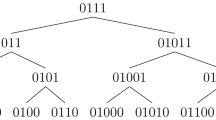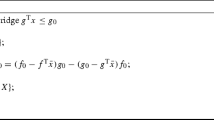Abstract
This paper is devoted to the design of an orthogonal systolic array ofn(n+1) elementary processors which can solve any instance of the Algebraic Path Problem within only 5n−2 time steps, and is compared with the 7n−2 time steps of the hexagonal systolic array of Rote [8].
Zusammenfassung
Es wird ein orthogonales systolisches Feld (systolic array) mitn(n+1) einfachen Prozessoren entworfen, das das algebraische Wegproblem in nur 5n−2 Schritten lösen kann, im Vergleich zu 7n−2 Schritten beim hexagonalen systolischen Feld von Rote [8].
Similar content being viewed by others
Abbreviations
- C.1.2 [processor architectures]:
-
multiple data stream architectures (multiprocessors) — systolic arrays
- G.1.0 [numerical analysis]:
-
general-parallel algorithms
- G.1.3 [numerical analysis]:
-
numerical linear algebra-matrix inversion
- G.2.2 [discrete mathematics]:
-
graph theory-path problems
- B.6.1 [logic design]:
-
design styles-cellular arrays
- B.7.1 [integrated circuits]:
-
types and design styles-algorithms implemented in hardware
- VLSI:
-
(very large scale integration)
References
Ahmed, H. M., Delosme, J. M., Morf, M.: Highly concurrent computing structures for matrix arithmetic and signal processing. Computer15/1, 65–82 (1982).
Delosme, J. M.: Algorithms for finite shift-rank processes. Ph.D. Thesis, Technical Report M735-22, Sept. 1982, Stanford Electronics Laboratories.
Guibas, L. J., Kung, H. T., Thompson, C. D.: Direct VLSI implementation of combinatorial algorithms, pp. 509–525. Proc. Caltech Conf. on VLSI: Architecture, design, fabrication, Calfornia Institute of technology, Pasadena (1979).
Kung, H. T.: Why systolic architectures. Computer15/1, 37–46 (1982).
Kung, H. T., Lam, M. S.: Fault-tolerance and two-level pipelining in VLSI systolic arrays. Journal of Parallel and Distributed Computing1/1, 32–63 (1984).
Kung, H. T., Leiserson, C. E.: Systolic Arrays (for VLSI). In: Proc. of the Symposium on Sparse Matrices Computations, pp. 256–282 (Duff, I. S., Stewart, G. W., eds.). Knoxville, Tenn. (1978).
Robert, Y.: Block LU decomposition of a band matrix on a systolic array. Int. J. Computer Math.17, 295–315 (1985).
Rote, G.: A systolic array algorithm for the algebraic path problem (shortest paths; matrix inversion). Computing34, 191–219 (1985).
Rote, G.: A systolic array for the algebraic path problem (which includes the inverse of a matrix and the shortest distances in a graph). Rechenzentrum Graz, Austria, Bericht RZG-101 (1984).
Zimmermann, U.: Linear and combinatorial optimization in ordered algebraic structures. Ann. Discrete Math.10, 1–380 (1981).
Author information
Authors and Affiliations
Rights and permissions
About this article
Cite this article
Robert, Y., Trystram, D. An orthogonal systolic array for the algebraic path problem. Computing 39, 187–199 (1987). https://doi.org/10.1007/BF02309554
Received:
Issue Date:
DOI: https://doi.org/10.1007/BF02309554




